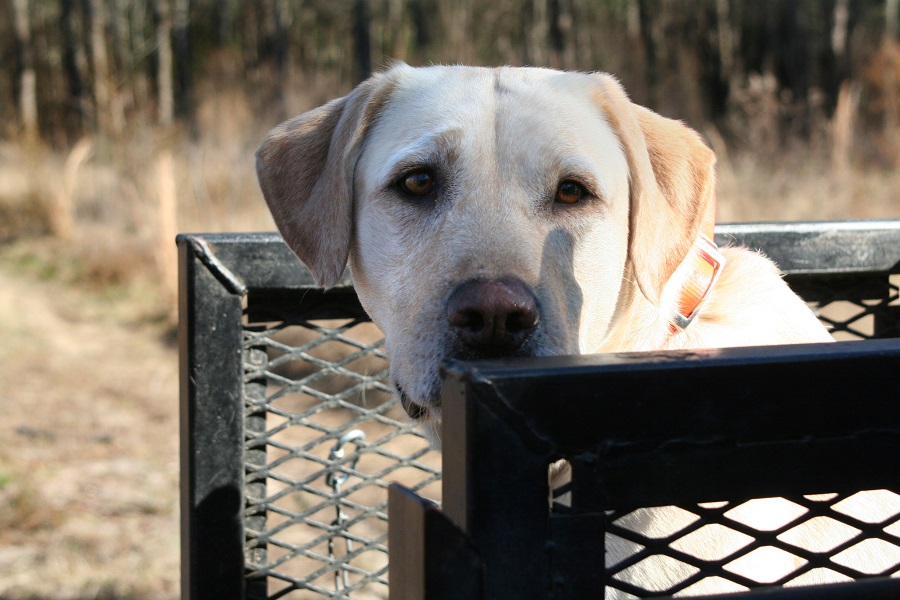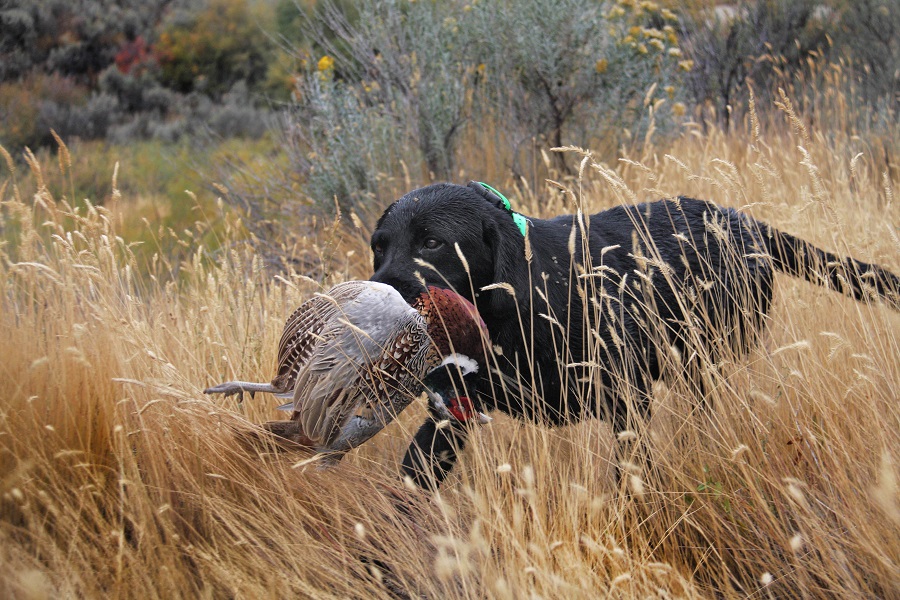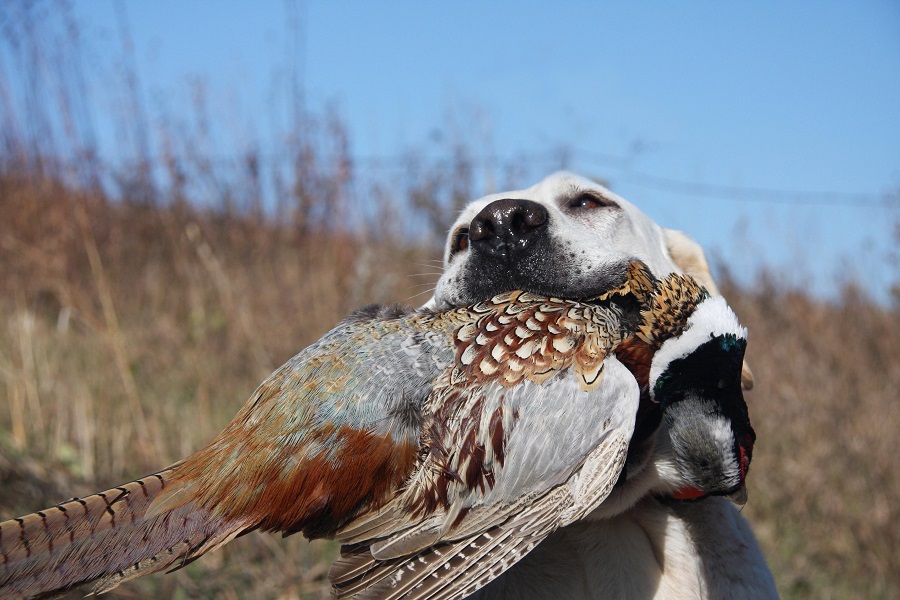You can’t not like a Lab. From the front porch snoozer and toddlers’ playmate to the keen gun dog flushing roosters in gun range, Labs are loved. For 24 years the Labrador retriever has ruled the roost as the American Kennel Club’s most popular breed. Labs also continue to have the highest registration numbers of all the gun dogs in the UK’s Kennel Club. They work as waterfowl retrievers, upland flushers, drug sniffers, therapy dogs, Seeing Eye dogs, and universal companions. It seems that nearly every good dog joke starts with a Lab – a Lab walks into a bar; the doctor ordered Lab tests and cat scans, three Labs were sitting on a bench....
While everyone loves a Lab, in the hunting world – particularly the upland hunting world – there are two camps: those who favor the blocky “British” or “English” Lab and those who favor the lanky “American” Lab. The British breed standard allows a height of 21.5 to 22.5 inches. The American standard permits a height of 21.5 to 24.5 inches (male and female included in these ranges). The British Labs are wider, with fuller chests, thick necks, clearly defined forehead stops, and shorter legs. The American Labs are slimmer, with a narrower head, longer muzzle, longer legs and athletically agile build. The American Labs’ tails tend to be thinner and may curve upward whereas the British Labs’ tails are thick and straight. The British Lab usually has a denser coat. The standard weight for male British Labs is 70-74 lbs.; for females it’s around 55 lbs. American Labs can weigh more.
Both types of Labs have a water-resistant double coat that comes in three colors: black, yellow, and chocolate, with “fox red” considered a subcategory of yellow. The black coat is dominant; chocolate is based on a recessive gene. There are very few chocolate British Labs. Breeders of both types of Labs avoid breeding chocolate to chocolate because of issues that may result from the pairing of recessive genes.
The differences between the two Labs goes deeper than height, coat and shape, however. Breeders’ and breed clubs’ consensus describes British Labs as calmer, quieter, softer and less active as opposed to the American Labs generally being more active with higher energy and greater drive.

The Labrador retriever breed is descended from Newfoundland’s St. John’s water dog that helped pull fishermen’s nets back in the 1800s. Labs joined the English Kennel Club’s registry in 1903 and were first registered by the American Kennel Club in 1917. It is important to note that neither the UK Kennel Club nor the AKC recognizes a difference between these two types of Labrador retriever. Both registries list one breed standard and do not differentiate despite the difference in English or American lineage.
Dennis and Janice Anderson of BritishLabradors.com have been breeding British Labradors for over 28 years in the St. Croix Valley of Wisconsin. Comparing the two types of Labs, Dennis says, “There are good dogs of all origins and great dogs of all origins.”
He goes on to explain that much of the difference between the two types of Labs stems from their training history and the type of hunting they do. The nature of British field hunting comes from a tradition of huge shoots involving hundreds of birds, put on over several days, often for royalty. The fundamental premise is that the dogs must be quiet and controlled at all times – civility is paramount.
“In Great Britain Labradors are used differently than they are in America. Also, the British have a different value system; that is, they emphasize different qualities in their retrievers. To be used on a shoot, or to compete in British field trials, a Labrador in Great Britain must fundamentally be quiet and still; alert but not nervous, even if hundreds of pheasants are being shot over him or her in a driven shoot. Once sent, British Labradors must retrieve game that is either killed dead or crippled. Consequently, they must be excellent game finders.”
Once they were introduced in America, the Labs’ job description diversified. Hunting is a more accessible, egalitarian pursuit in the U.S. Consequently, region, climate, and game species led breeders to develop lines suited to different types of upland or waterfowl hunting. European style shoots gave way to field trials and hunt tests which called for increased athleticism and drive. In response, not only the physical characteristics of the Labs’ changed, but their training methods did as well.

According to Dr. B. W. Zeissow in
The Origin and Purpose of the Labrador Retriever, “The American sportsmen adopted the breed from England and subsequently developed and trained the dog to fulfill the hunting needs of this country. Today, as in the past, the Labrador will eagerly enter in ice cold water in Minnesota to retrieve a shot bird; he'll work all day hunting doves in the heat of the Southwest – his only reward is a pat for a job well done.”
Pro-trainer Tom Dokken, author of
Retriever Training – the Complete Guide to Developing Your Hunting Dog and inventor of the Deadfowl Trainer, has been working with both types of Labs for over 30 years at Dokken’s Oak Ridge Kennels in Minnesota and around the country. He agrees that the British Labs tend to be a little calmer and the American Labs have higher drive, but he believes the differences aren’t that great.
“We train both,” Tom says. “Good field blood lines produce good upland dogs in both cases. Field bred British Labs can hold up in the pheasant fields as well as the American Labs. The American Labs’ drive gives them an advantage when it comes to late season, big water waterfowl work, but the two types are not way apart on two sides of the fence when it comes to training or working. They’re much closer than most people think.”
Some people believe that British Labs are much easier to train. “The line has to be drawn,” Tom says. “They don’t train themselves. You need a dog to have the desire to work and train, to take the discipline of training. They all need discipline, and a softer dog can be a more difficult dog for an amateur to train. Amateur trainers need dogs that have a natural ability to take discipline and that can recover easily if the trainer makes a mistake.”
Tom adds that the American Labs’ greater drive doesn’t take away from their trainability. “They have the smarts and natural desire to work hard and train hard.”
.jpg.aspx)
Both types of Labs make terrific family dogs. As Tom explains, “Ninety-five percent of Labs are house dogs. That means that from seven weeks on, ground rules are set and they learn to recognize the control and be part of the family.”
Some breeders and clubs claim the difference between the British and American Labs should be more appropriately described as the difference between show lines and field lines, the British style being developed for show ring conformation and the American standard for field work. However, statements to that effect are usually followed by a disclaimer noting that there are field-bred British Labs and show-bred American Labs. As with many gun dog breeds, individual lines are often developed to suit one or the other purpose – the show ring or the field – sacrificing characteristics important to one over the other depending on the breeders’ objectives.
Hunters interested in getting a Lab, British or American, should do their research and find breeders who hunt and breed for the field. It can also make a difference if the field breeders’ priority is field trialing, waterfowl retrieving or upland hunting. Dennis adds another important criteria. “The key is to find a breeder who stresses health – eyes, hips, elbows.... A healthy dog is the best dog.”
Story and photos by Nancy Anisfield